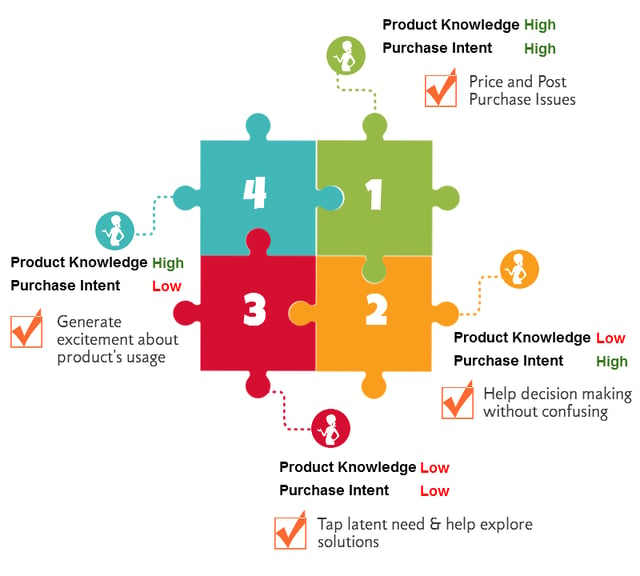
If we focus on the retailing of high involvement goods, interaction with in-store sales staff is arguably the most pivotal element of the shopper journey. It is also important to realize that not all shoppers visit the stores with same objectives. As soon as we understand this, it becomes clear that a standard approach will not suit interaction with different types of shoppers.
To provide a delightful shopping experience through in-store sales assistance, retailers and brands must therefore focus on guiding the intent and capability of their in-store sales staff based on this understanding. In the following section, we’ll discuss one approach to develop and implement such behaviour for your in-store sales staff.
We started by identifying parameters to segment shoppers and developing a framework which will guide the profiling of shoppers. Based on two key imperatives for in-store sales staff- 1. Driving purchase intent of shoppers and 2. Delivering knowledge of product/category to shoppers, we have come up with four types of shoppers.
(also highlighting the approach with which each shopper type should be serviced)–
4 Types Of Shoppers In Your Store

Shoppers with High Product Knowledge and High Purchase Intent
This is the stage where shoppers have made up their mind on purchasing a product and they are also aware about the features and benefits. As the purchase is high involvement, they are still interested in any additional opinion/information to minimize post purchase dissonance.
How should In-store sales staff service them : Sales Staff Skill Levels
Unsatisfactory - Unsatisfactorily answers the questions related to post purchase issues such as after sales service and switching process
Customary - Talks about price and promotions to assure shoppers that they are getting the best deal
Exemplary - Subtly reinforces the decision and explains the shopper about how to handle post purchase issues. Also cites feedback from other users
Shoppers with Low Product Knowledge and High Purchase Intent
These shoppers have a clear and urgent need but they don’t know much about the product/category features (and they might not be buying the product for own use). In this case, they are likely to delay the purchase and visit more stores before finally deciding on the purchase.
How should In-store sales staff service them : Sales Staff Skill Levels
Unsatisfactory - Tries to show all the options to shoppers in terms of price range and features and eventually end up confusing them
Customary - Sensing a high purchase intent asks for price range and recommends products while explaining the USPs and other benefits
Exemplary - Establishes credibility by demonstrating a genuine intent to help shopper make the right decision. Refrains from pushing any product
Shoppers with Low Product Knowledge and Low Purchase Intent
This type of shoppers are primarily in the early stage of decision making process. Their primary intent is to know about the product and relate it to their needs.
How should In-store sales staff service them : Sales Staff Skill Levels
Unsatisfactory - Shows no interest in helping the shoppers as soon as they sense low intent to purchase
Customary - Asks questions about the needs and price range and tries to match them with the available products
Exemplary - Educates shoppers about usage and benefits of products also help them understand differences between various options
Shoppers High Product Knowledge and Low Purchase Intent
Shoppers in this segment already know a lot about the product/category but are not convinced to buy it. The reasons for low purchase intent can be many. Two leading reasons are: 1. They don’t see a clear need for the product. 2. They don’t find the offering to be of good value for the money to be paid.
How should In-store sales staff service them : Sales Staff Skill Levels
Unsatisfactory - Tries to talk about price and promotions while ignoring the root of the problem in shopper decision making
Customary - Mentions key USPs of the product and ask shoppers about their needs/preferences
Exemplary - Generates excitement about product usage through possibilities and real life examples of the value of product features in order to identify and relate to latent needs

















.png)